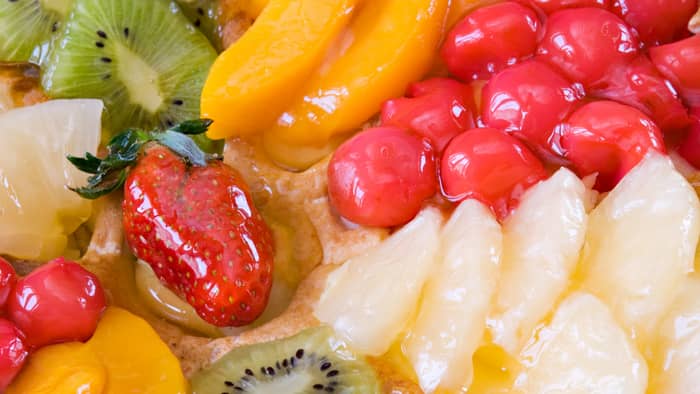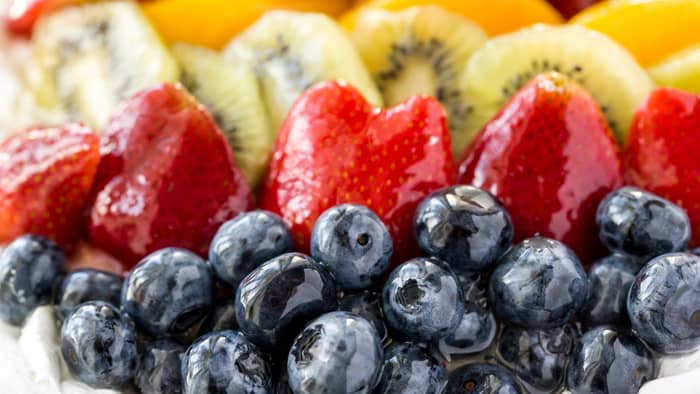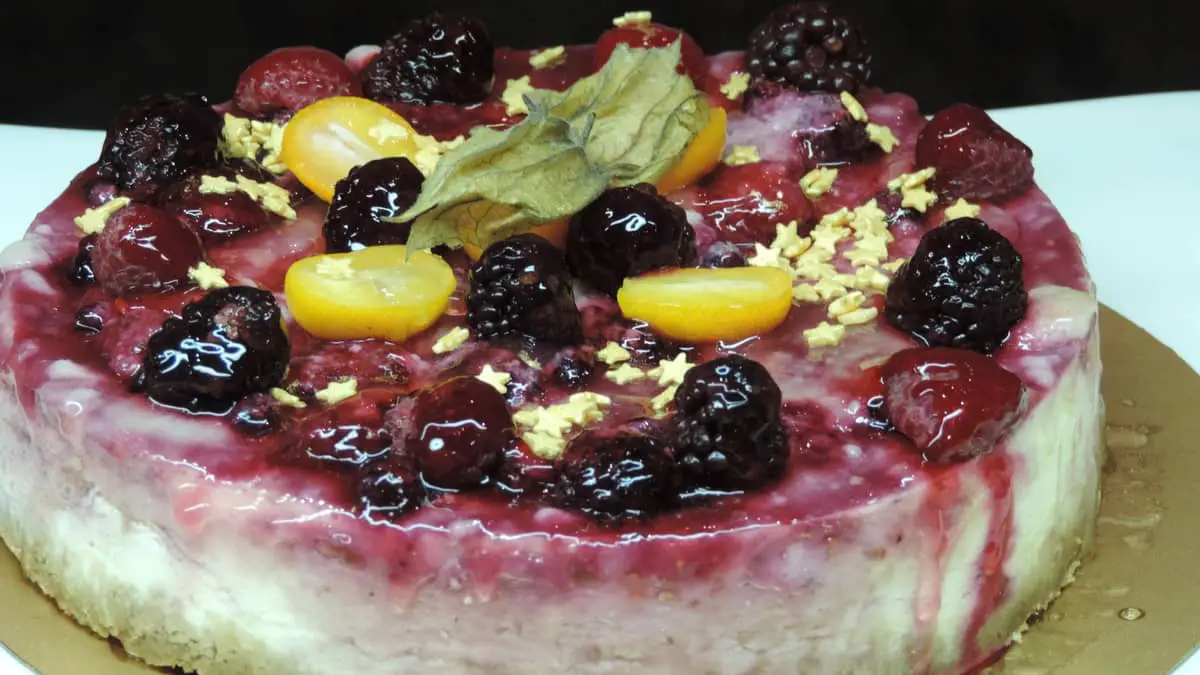By Lindy Van Schalkwyk, last updated on October 3, 2024
A fruit glaze for cheesecake has many important functions. We’ll explore, exactly how to make it, and even how to adjust the consistency!
These fruit glazes will help elevate your dishes, add a ton of flavor, and help preserve them for a longer time!
What Is A Glaze?
Before we look at what a fruit glaze is, we thought that it would be helpful if we first clarified what exactly a regular glaze is. When you think of the word, the first thing that might come to mind would be a delicious glazed donut or a glaze for a drip cake. And you definitely aren’t wrong.
The traditional definition of a glaze is a coating applied to the exterior of a food item via dipping, dripping, or brushing it on. These coatings can either be savory or sweet.
What is a fruit glaze for cheesecake?
Imagine fruit glazes being like a thinned-down fruit jam that is completely smooth and mostly translucent. They are extremely sweet because they mainly consist of fruit and sugar. This can make them easily overpower dishes, which is why they are only applied in a thin coating with a pastry brush.
A fruit glaze for cheesecake pretty much has the same functions as the glaze has for other items. So, there is no need to make any major adjustments to your recipes.
These glazes can be made in two main ways. The first is when you make them from scratch using fresh fruits, sugar, and water. The second method to use is to simply adjust the consistency of store-bought fruit glazes. Naturally, making the fruit glaze from scratch will take up a lot more time, but it has its own set of benefits.

What Is A Fruit Glaze Used For?
These glazes have a multitude of functions. These functions even change depending on which item you use it on! And, if you ever think of skipping it, trust us, it’s not worth it.
So, let’s get right to it!
1. Preserves freshly cut fruit
Arguably the most common use for fruit glazes is that it helps preserve freshly cut fruit. And, fresh fruit is one of the most used toppings for cakes, cheesecakes, tarts, and a variety of other baked goods.
As you may know, once the fruit has been cut they instantly start to deteriorate. They undergo textural changes and can become mushy and dry. Their flavor also becomes bland and some fruits will even get a tart acidic flavor.
The addition of a thin layer of fruit glaze can extend the shelf life of these cut fruits tremendously! You will lengthen it from about a day to roughly 3 or 4! That’s incredible, right?
So, now you may be wondering how exactly this happens? Well, because of the extremely high sugar contents inside of the glaze, it acts as a protective layer against outside elements.
2. Preserves moisture in baked items
When you apply a thin layer of fruit glaze to the surfaces of your baked goods, it will essentially act in a similar way to preserving freshly cut fruits.
The high sugar content and gellish layer will prevent oxygen from drying out your items, while simultaneously adding more moisture of its own. When using this fruit glaze for cheesecake, it will also extend its shelf life and preserve the flavor.
3. Adds flavor to your goods
Now, depending on which fruit you use to make your fruit glaze, you can add a ton of deliciously sweet fruity flavor to your item. And, you can use virtually any kind of fruit that you’d like!
We always prefer using an apricot-based glaze because of how relatively neutral its flavor is. It merges seamlessly with loads of baked items, and you cannot go wrong! it also doesn’t have noticeable color, meaning that the natural colors of your cut fruit or baked item will shine through!
4. Adds a shiny gloss
Now, if you have ever wondered why the fruit tarts and baked goods look so incredibly moist and decadent in bakeries, it’s because they add a thin layer of the fruit glaze.
These glazes can give your items a fresh look, and a shiny coating, and make them drool-worthy!
How Do You Make A Fruit Glaze For Cheesecake?
Now, let’s get to the good part! Making a fruit glaze for cheesecake is incredibly easy and even quick! And, there are a couple of ways you can do it.
The first is to essentially make a fruit jam, then adjust the consistency, and finally strain it. This method will take you quite some time but will produce an extremely flavorful all-natural product.
The second method, and the one most people use, is to simply thin some pre-made jam or jelly. For cheesecake, we would recommend using an apricot jam. Unless you have a strawberry or blueberry cheesecake (as an example) for which you can use a strawberry or blueberry fruit glaze instead to match the flavor profile.
Whichever one you choose, they have to be completely smooth and free of any tiny seeds too.
Adjusting The Consistency Of A Fruit Glaze For Cheesecake
A fruit glaze for cheesecake (in general really) should have a thick spreadable consistency. It shouldn’t be watery or runny, but it also shouldn’t be hard to brush on.
The consistency will vary to a certain extent depending on where you use it. For example, when brushing the surface of a cheesecake, you don’t necessarily need it to be very thin. but, if you are brushing delicately cut fresh fruit, you would need a thinner glaze.
How to thin a fruit glaze?
To thin a fruit glaze for cheesecake, you can slowly add a teaspoon of water while whisking well. Do not add too much at a time, otherwise, it will become too runny to use or work effectively.
You can also add a thin simple syrup to prevent watering down the flavor.
How to thicken a fruit glaze for cheesecake?
To make a glaze thicker, you can cook it over low medium heat to slowly evaporate any excess liquid. Stir frequently to prevent the mixture from burning.
Alternatively, you can add some corn starch, but you will have to boil the mixture again to cook out the starchy flavor and texture. Then, allow it to completely cool before brushing your items.

Final Thoughts On Fruit Glaze For Cheesecake
There are hundreds of ways you can use a fruit glaze for cheesecake and other baked goodies. And, if you ever need some inspiration and guidance on using it, feel free to ask us in the comments below!
Read more about How To Make A Fruit Topping For Cheesecake?
FAQs
[rank_math_rich_snippet id=”s-7fab1c81-f574-416f-9077-3b5e2742f4f7″]

Lindy Van Schalkwyk is a culinary specialist with a background in Advanced Cooking, Advanced Pâtisserie, Media Communications and Nutrition. She has gained invaluable experience in the culinary industry having worked in some of the top restaurants in Africa in 2016 and 2017. Her expertise in nutrition has enabled her to develop recipes for special dietary needs. In 2018, Lindy began working in the Food Media industry, focusing on recipe development, recipe writing, food writing and food styling.

